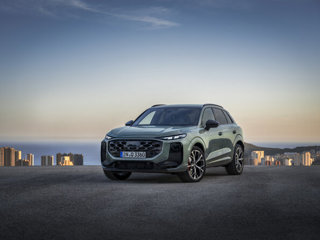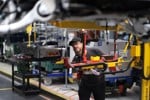When Fleet News first interviewed Audi UK head of direct sales Warren Richards in May 2023, four months after his appointment, the message was clear: ‘we’re going back to basics to re-engage with customers’.
Audi isn’t the only manufacturer pressing re-set; several have outlined variations on the theme of ‘being easy to do business with’, seeking to counter some damning criticism by fleets about deteriorating communications and underwhelming standards of service.
Richards was determined to tackle this view head on, while simultaneously believing Audi’s own relationships with fleets were already healthier than many of its rivals.
Fourteen months on and what impact is his ‘back to basics’ strategy having on fleet relationships and – crucially – Audi’s true fleet registrations?
“We have addressed customer concerns on specification, availability and delivery times – we are over that now,” Richards said, emphatically.
“We have had a great year so far. We are number three overall in true fleet with a 9.9% market share and number two in premium.
“We’ve made great progress in our back-to-basics plan: we are out with customers, talking to them about their future needs, our cars and our services. We understand what’s frustrating for them and where we can help, especially with electrification, ownership, charging and conversations with their own drivers.”
When Fleet News first interviewed Audi UK head of direct sales Warren Richards in May 2023, four months after his appointment, the message was clear: ‘we’re going back to basics to re-engage with customers’.
Audi isn’t the only manufacturer pressing re-set; several have outlined variations on the theme of ‘being easy to do business with’, seeking to counter some damning criticism by fleets about deteriorating communications and underwhelming standards of service.
Richards was determined to tackle this view head on, while simultaneously believing Audi’s own relationships with fleets were already healthier than many of its rivals.
Fourteen months on and what impact is his ‘back to basics’ strategy having on fleet relationships and – crucially – Audi’s true fleet registrations?
“We have addressed customer concerns on specification, availability and delivery times – we are over that now,” Richards said, emphatically.
“We have had a great year so far. We are number three overall in true fleet with a 9.9% market share and number two in premium.
“We’ve made great progress in our back-to-basics plan: we are out with customers, talking to them about their future needs, our cars and our services. We understand what’s frustrating for them and where we can help, especially with electrification, ownership, charging and conversations with their own drivers.”
Audi’s true fleet registrations have risen almost 9% according to SMMT stats. And its BEV registrations as a percentage of total sales are around 18% - one of the highest in the UK. It remains below the 22% ZEV Mandate target but is likely to be enough to ensure compliance based on the 2021 emissions benchmark set for each manufacturer.
Award-winning electric cars
With a strong BEV roadmap over the next couple of years - including Q6 e-tron, with almost 400 miles of range and the 400+ miles A6 e-tron (concept due in August) - Audi could easily borrow against future credits if necessary. Meanwhile, the Fleet News Award winning Q4 e-tron (a category sponsored by Ogilvie Fleet) has also been updated this year with improved range and performance.
“We have launched 12 variants this year and have nine more to come, with even more next year,” Richards said. “We have our eye on the [ZEV] target and with the new models we would expect to achieve it.”
Don’t expect a raft of new niches though; most launches will be BEV and PHEV variants within existing segments.
Indeed, while other manufacturers, including some within the Volkswagen Group stable, have introduced electric car naming strategies that have confused customers, Audi has no plans to stray from the A1 to Q8 monikers that have served so well to underpin its premium marque brand equity.
“It has logic, and it continues to make sense,” Richards said.
It also helps Audi to fend off new market entrants from China. Richard says they should be “treated with respect” and a few will undoubtedly “make their mark with amazing products”, but Audi’s brand equity and long-established relationships with fleet partners will ensure a successful future, he adds.
During the transition period, Audi’s with even numbers will be full electric, those with odd numbers will be ICE, as the company builds towards its 2030 strategic target of BEV accounting for 75% of global sales. In Europe, the target is 100% electrically powered from 2035.
“We are sticking to our electric strategy. In the transformation phase, however, a flexible range of drive systems is important because regions around the world are developing at different speeds,” Richards said.
“We can meet demand: customers can choose between efficient combustion engines, powerful plug-in hybrids and purely electric models. The model range enables us to meet all customer demand and at the same time drive electrification forward at full speed.”
Countering residual value drops
Year-to-date, Audi has also pushed hard into the Motability sector – again echoing strategies deployed by its VW Group stablemates – with registrations more than doubling from 3,425 in 2023 to 8,062 today. Electric is playing a big role here, too, but are there any concerns about the falling residual values?
Richards believes the reductions seen over the past 18 months or so simply reflect a market that is normalising back to more sustainable levels.
Audi has taken steps to incentivise used buyers – and give its own retailers confidence in the product - by including a free wallbox charger with every sale.
Meanwhile, its ‘make a switch’ campaign focused on overcoming myths and how retailers should speak to consumers about electric cars.
“The sentiment in the Audi network is positive; we have a good BEV used car market,” Richards said.
“We have educated customers and our retailers to talk confidently about new and used BEVs, including cost of ownership and how to use them. It will help to stabilise residual values.
“Part of this is to normalise the market. It’s not future tech; it’s here and now.”
While Motability volumes are on the rise, Audi continues to reverse out of rental, with registrations down in the first half of the year by more than 40%, at 1,249 units. That will further protect RVs, while ensuring Audi has better control about when and how BEVs return to market.
This will prove crucial and newer models, with better technology, come to market. Audi is investing heavily in technology to support battery assembly with a focus on range and speed of charging. Solid state baterry technology is an exciting option with a “range of possibilities”, according to Richards.
“It’s a race to get range as high as possible,” he said.
Balancing range and cost
However, Audi also believes there is a balance to strike between range, cost and weight, with different markets – and buyers – having different priorities. For some, affordability will be more important and range.
Future models will also integrate bi-directional charging which Richards describes as “not necessarily solving a problem but it gives people another reason to buy a BEV”.
However, hydrogen is not on the current roadmap. The environmental sustainability is, said Richards, “questionable”, adding: “You have to back a technology; it’s not practical to invest in everything”.
This is doubly true when Audi continues to spend big on safety technology, connectivity and AI, which feature heavily in the forthcoming Q6. The voice activation is intelligent and supported by AI, with the car acting on what it hears.
“If you say, my feet are cold, the car will react [by putting on the heaters]. It understands 800 different commands and learns as well,” Richards said.
“It’s a more intelligent approach and improves safety because you continue to focus on the road [compared to reliance on touchscreens]. You don’t have to look at buttons, switches or screens.”
The juxtaposition of the increasing technological complexity coursing through Audi’s newest models with the outcome of providing a simpler experience for the driver, mirrors the immense work behind the scenes to provide a straightforward, back to basics experience for the fleet decision-maker.
It continues to augment Richards’s fleet strategy.
“My priorities? To continue doing what customers want: feeding them information, keeping them informed, helping them to understand why electric vehicles are good,” he said.
Login to continue reading.
This article is premium content. To view, please register for free or sign in to read it.
























Login to comment
Comments
No comments have been made yet.